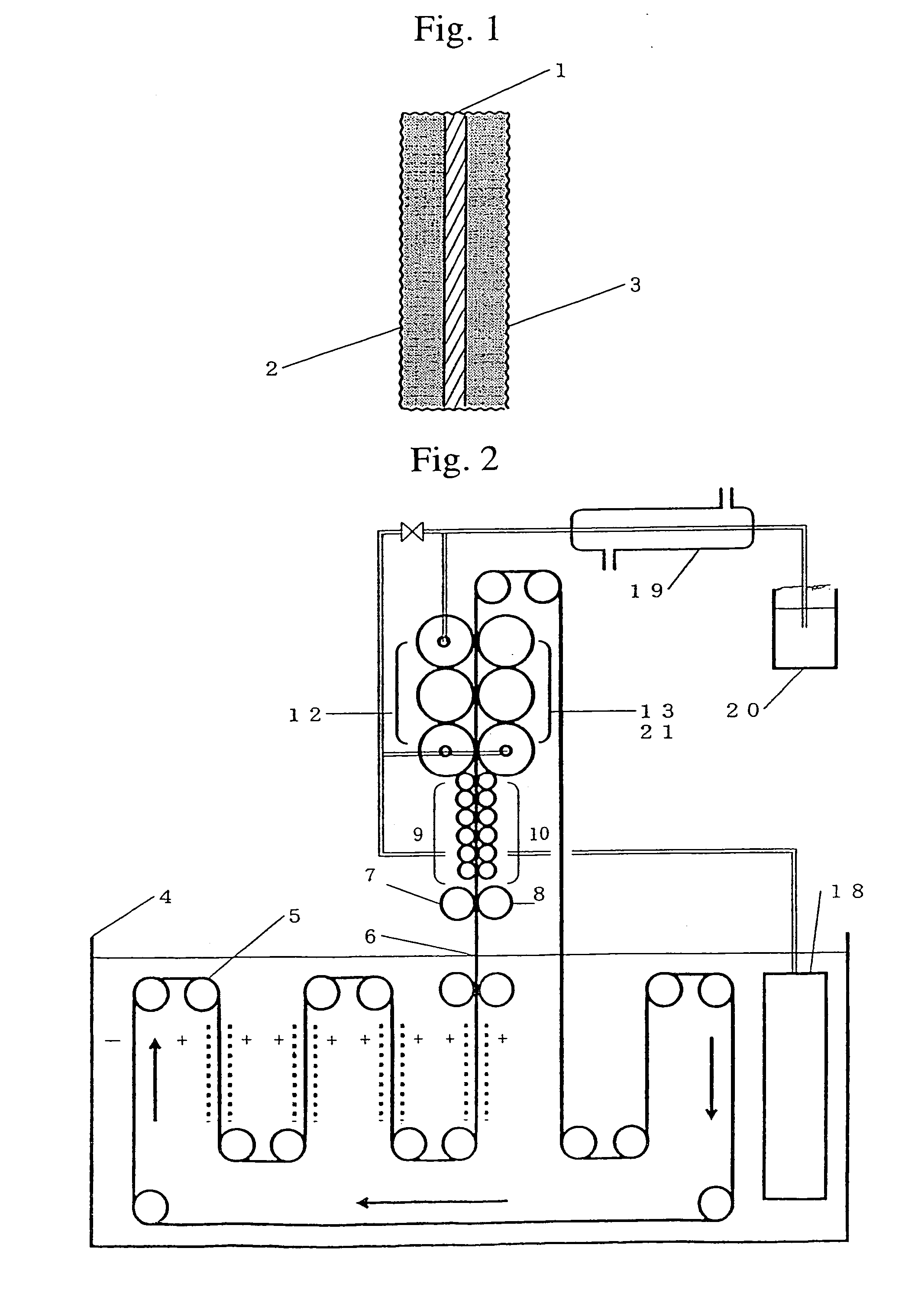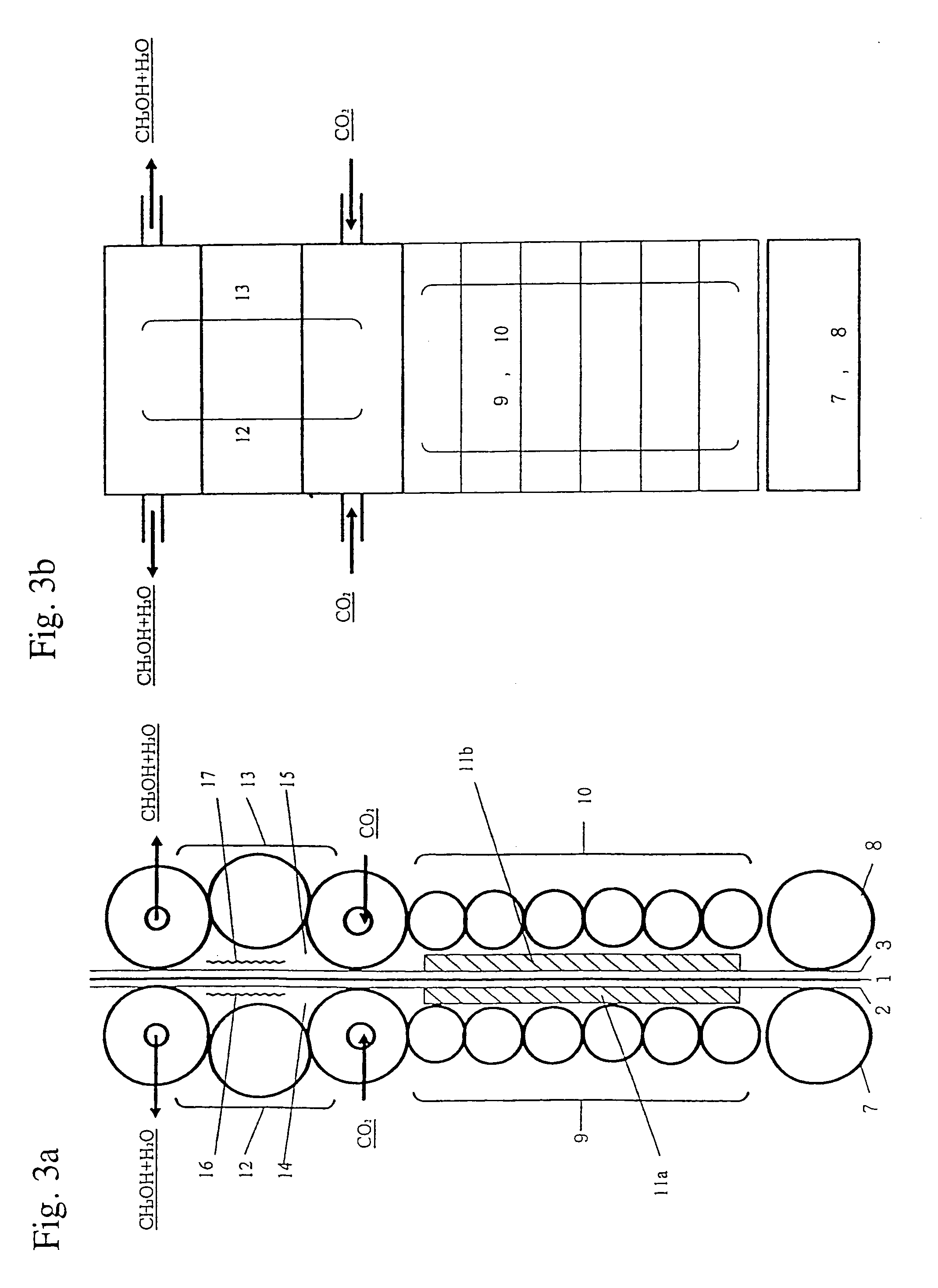Method for hydrogenating carbon dioxide, treating apparatus, and basic material for hydrogenation
a carbon dioxide and hydrogenation technology, applied in the field of hydrogenation process, can solve the problems of low efficiency of these techniques, low rate of processing, and serious drawbacks of conventional techniques, and achieve the effects of high temperature, low conversion rate, and high capacity for processing carbon dioxid
- Summary
- Abstract
- Description
- Claims
- Application Information
AI Technical Summary
Benefits of technology
Problems solved by technology
Method used
Image
Examples
example 1
[0027]As shown in FIG. 2, a strip of thin copper base plate 1 (thickness: 0.1 mm) is electrolyzed while being guided in the upward and downward directions among plural drive rollers 5 in an electrolyte accommodated in an electrolytic bath 4, and it migrates forward. An electrolyte to be used is an emulsion comprising 50 g of zinc oxide powder per liter of a solution comprising 100 g of caustic potash per liter thereof. The base plate 1 that migrates within an electrolyte while employing anode of insoluble plates, such as zinc plates, immobilized on both of its sides. The base plate 1 continuously migrates forward while being electrolyzed cathodically at 5 A / dm2 by adopting the insoluble plates as anodes and the base plate 1 as a cathode. Active porous metallic zinc layers are deposited and immobilized on both sides of the base plate 1 during this electrolysis. The amount of zinc to be deposited is adjusted by regulating the current density of the electrolysis on both sides of the ba...
example 2
[0038]The description made in Example 1, line 10 on page 8 to line 3 on page 9, is also applicable in this example.
[0039]As shown in FIG. 2, when copper oxide powders are sprinkled on the porous metallic zinc layer 2 provided on one side of the base plate 1 before the base plate enters to roller 7, portions of the porous layer are reduced to metallic copper with the aid of metallic zinc. However, other portions form a porous metallic zinc layer comprising copper oxide. In such a case, the aforementioned additional substances that can be used as subcatalyst for zinc oxide or copper oxide catalysts may be incorporated therein.
[0040]Thus, the base plate 1 migrates upward to be sandwiched between plural rotating drive rollers. FIG. 4a (an elevational view) and FIG. 4b (a plane view) are detailed and enlarged diagrams showing this procedure. The drawings are roughly divided to show the group 9 of drive rollers for generating hydrogen as shown in Chemical Formula 3, the group 10 of drive ...
example 3
[0045]The description made in Example 1, line 10 on page 8 to line 10 on page 9, is also applicable in this example.
[0046]In this example, the base plate 1 migrates upward between plural rotating drive rollers. FIGS. 5 is an enlarged diagram showing a major part of an apparatus for hydrogenating carbon dioxide, and show a process for hydrogenating carbon dioxide for additionally explaining the apparatus and the process described in Example 1 and shown in FIG. 3a and FIG. 3b. More specifically, with the utilization of the apparatus and the process for hydrogenating carbon dioxide, water can be immediately and continuously discharged to the outside of the reaction system simultaneously with the generation of the reaction product shown in the right-hand side of Chemical Formula 1, thereby enhancing the rate of conversion with low chemical equilibrium and enhancing the yield of methanol. The explanation thereof is the same as described from line 10 on page 6 to line 24 on page 7.
[0047]I...
PUM
| Property | Measurement | Unit |
|---|---|---|
| temperature | aaaaa | aaaaa |
| temperature | aaaaa | aaaaa |
| partial pressure | aaaaa | aaaaa |
Abstract
Description
Claims
Application Information
 Login to View More
Login to View More - R&D
- Intellectual Property
- Life Sciences
- Materials
- Tech Scout
- Unparalleled Data Quality
- Higher Quality Content
- 60% Fewer Hallucinations
Browse by: Latest US Patents, China's latest patents, Technical Efficacy Thesaurus, Application Domain, Technology Topic, Popular Technical Reports.
© 2025 PatSnap. All rights reserved.Legal|Privacy policy|Modern Slavery Act Transparency Statement|Sitemap|About US| Contact US: help@patsnap.com



